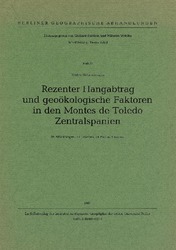Rezenter Hangabtrag und geoökologische Faktoren in den Montes de Toledo Zentralspanien
Gehrenkemper, Kirsten
Selbstverl. des Inst. für Phys. Geographie der Freien Univ. Berlin, Berlin
Monografie, digitalisiert
Deutsch
Weitere Online-Version: http://resolver.sub.uni-goettingen.de/purl?PPN1020551518
Gehrenkemper, Kirsten, 1981: Rezenter Hangabtrag und geoökologische Faktoren in den Montes de Toledo Zentralspanien. Berliner geographische Abhandlungen, 34, 86 S., DOI: 10.23689/fidgeo-2859.
 |
Dokument öffnen: |
[contains vegetation map] ; [contains relief map].
Summary: As studies in the area bordering the Montes de Toledo have shown, the factors influencing soil erosion are vegetation, climate, relief intensity, soil-physical characteristics and human activity.
In order to analyse in detail the causes and effects of soil erosion in Central Spain‚ climatic data (rainfall and temperature) of the area were evaluated and special attention was paid to extreme data such as rain storms.
Relief intensity. the second important factor determining soil erosion. was extrapolated by measuring slope steepness in the study area and extending these results with the help of the slope steepness map to cover the Montes de Toledo area.
On the basis of the "mapa forestal de Espana 1:400 000" the vegetation type of the various sub-areas was established and proved to be a factor impeding erosion.
The extent of erosion risk depends on soil-physical characteristics such as cohesion, infiltration capacity and permeability, which are determined by means of soil particle size analysis and the measurement of hydraulic conductivity and infiltration. A comparison of these data with erosion gauge measurements produced the following results: Surfaces with vegetation cover provide the most effective check to erosion.
Given a dense plant cover, slope steepness plays only a minor role up to a certain critical angle, which is 20° in the study area; the maximum rate of erosion here averages (-0.1) cm per year. Given sparse plant cover, the values rise to (-0.3) cm per year; given a completely bare surface. erosion reaches an annual average of (-0.4) cm at up to 5° slope steepness. (-1.0) cm at up to 10°. (-1.3) cm at 15°, and (-1.8) cm at 20°. On slopes with an inclination over 20°, up to (-0.9) cm of soil erosion per year were measured, even when the vegetative cover was dense.
The relations soil erosion-slope length and soil erosion-slope form are modified according to the Situation of individual gauges on the slopes.
As well as vegetation and slope steepness, soil structure was shown to be a differentiating parameter in recent slope erosion. Comparative measurements of K-values on sandy-gritty weathered detritus of granite and on the partly loamy-clayey substrata of the ranas and the weathering mantles in quarzite showed differences in the capacity to absorb water ranging from 1.2 x 10-3 cm/sec to 1.3 x 10-4 cm/sec.
The evaluation of the precipitation data showed that, in this Climatic area, each rainfall is an erosion hazard, varying, however, according to type and intensity. It was shown that roughly a third of the annual slope movements take place in the summer half-year (April - September). These are caused by an increase in thunderstorms and a loose ground cover. Two-thirds of the entire movements occur during the winter half-year (October – March), when precipitation in the form of continuous steady and storm rainfall increases.
A further cause of increased soil erosion is the human factor. Slope sections that have undergone large-scale cultivation and overgrazing show dear evidence of erosion and denudation. On the other hand, the farming of small units of land, the construction of terraces on the slopes and cultivation on the contour represent effective measures against widespread erosion.
Statistik:
ZugriffsstatistikSammlung:
 CC BY 4.0
CC BY 4.0

